Ever wondered about Futures Spread Trading? In this article the author looks at the basics and the best way to trade them.
How professional traders optimize profits
Futures spread trading is probably the most profitable, yet safest way to trade futures. Almost every professional trader uses spreads to optimize his profits. Trading spreads offers many advantages which make it the perfect trading instrument, especially for beginners and traders with small accounts (less than $10,000).
The following example of a Soybean-Spread shows the advantages of futures spread trading:
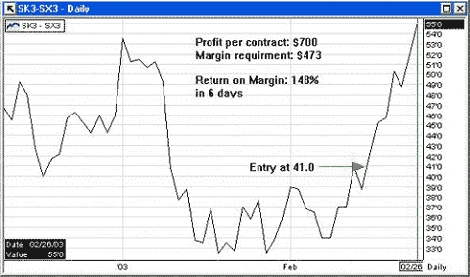
Example: Long May Soybeans (SK3) and Short November Soybeans (SX3)
Four Advantages of Futures Spread Trading
Advantage 1: Easy to trade
Do you see how nicely this spread starts trending in mid February? Whether you are a beginner or an experienced trader, whether you use chart formations or indicators, the existence of a trend is obvious. Spreads tend to trend much more dramatically than outright futures contracts. They trend without the interference and noise caused by computerized trading, scalpers, and market movers.
Advantage 2: Low Margin requirements
Many spreads have reduced margin requirements, which means that you can afford to put on more positions. While the margin on an outright futures position in corn is $540, a spread trade in corn requires only $135 -- 25% as much. That's a great advantage for traders with a small account. With a $10,000 trading account risking 8% of your account, you can enter 6 corn spreads, instead of only 1-2 outright corn futures trade. How's that for leverage?
Advantage 3: Higher return on margin
Each point in the spread carries the same value ($50) as each point in the outright futures ($50). That means that on a 3 point favorable move in corn futures or a 3 point favorable move in the spread, you would earn $150. However, the difference in return on margin is extraordinary:
Corn futures - $150/$540 = 27.8% return
Corn spread - $150/$135 = 111% return
And keep in mind that you can trade 6 times as many spread contracts as you can outright futures contracts. In our example you would achieve a 24 times higher return on you margin.
Advantage 4: Low time requirements
You don't have to watch a spread all day long. You do not need real-time data. The most effective way to trade spreads is using end-of-day data. Therefore, spread trading is the best way to trade if you do not want to watch or cannot watch your computer all day long (i.e. because you have a daytime job). And you can save all the money you would have had to spend for real-time data systems (up to $600 per month).
So where is the catch?
If futures spread trading is so fantastic, why does it seems that hardly anybody trades spreads? Well, it is not true that hardly anybody trades spreads: the professional traders do, every day. But either by accident or design, the whole truth of spread trading has been hidden from the public over the years.
The purpose of this website is to inform you about futures spread trading. In the following we will answer the four frequently asked questions:
What Is a Spread?
A spread is defined as the sale of one or more futures contracts and the purchase of one or more offsetting futures contracts. You can turn that around to state that a spread is the purchase of one or more futures contracts and the sale of one or more offsetting futures contracts. A spread is also created when a trader owns (is long) the physical vehicle and offsets by selling (going short) futures.
Furthermore, a spread is defined as the purchase and sale of one or more offsetting futures contracts normally recognized as a spread by the fact that the two sides of the spread are actually related in some way. This explicitly excludes those exotic spreads put forth by some vendors, which are nothing more than computer generated coincidences which are not in any way related. Such exotic spreads as Long Bond futures and Short Bean Oil futures may show up as reliable computer generated spreads, but bean oil and bonds are not really related. Such spreads fall into the same category as believing the annual performance of the U.S. stock market is somehow related to the outcome of the Super Bowl sporting event.
In any case, for tactical reasons in carrying out a particular strategy, you want to end up with:
The primary ways in which this can be accomplished are:
Intramarket Spreads
Officially, Intramarket spreads are created only as calendar spreads. You are long and short futures in the same market, but in different months. An example of an Intramarket spread is that you are Long July Corn and simultaneously Short December Corn.
Intermarket Spreads
An Intermarket spread can be accomplished by going long futures in one market, and short futures of the same month in another market. For example: Short May Wheat and Long May Soybeans.
Intermarket spreads can become calendar spreads by using long and short futures in different markets and in different months.
Inter-Exchange Spreads
A less commonly known method of creating spreads is via the use of contracts in similar markets, but on different exchanges. These spreads can be calendar spreads using different months, or they can be spreads in which the same month is used. Although the markets are similar, because the contracts occur on different exchanges they are able to be spread. An example of an Inter-exchange calendar spread would be simultaneously Long July Chicago Board of Trade (CBOT) Wheat, and Short an equal amount of May Kansas City Board of Trade (KCBOT) Wheat. An example of using the same month might be Long December CBOT Wheat and Short December KCBOT Wheat.
Why Spreads?
The rationale behind spread trading is one of the best-kept secrets of the insiders of the futures markets. While spreading is commonly done by the market "insiders," much effort is made to conceal this technique and all of its benefits from "outsiders," you and me. After all, why would the insiders want to give away their edge? By keeping us from knowing about spreading, they retain a distinct advantage.
Spreading is one of the most conservative forms of trading. It is much safer than the trading of outright (naked) futures contracts. Let's take a quick look at some of the benefits of using spreads:
What Can You Expect?
Here is an example of what you can expect from Intramarket spread trading. We think you may be pleasantly surprised!!
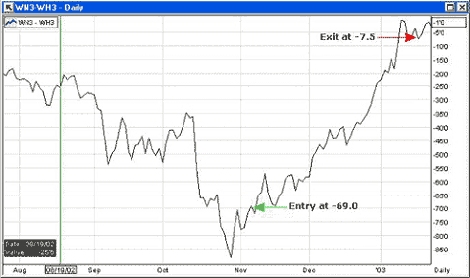
This spread was entered not only on the basis of seasonality, but also by virtue of the formation known as a Ross hook (Rh). The spread moved from -69.0 to -7.5 = $3,075 per contract. The margin required to put on this spread was only $608, thus the return on margin is more than 500%.
Here is an example of an Intermarket spread. Look at the the following chart: Would you want to have been long live cattle from December until February?
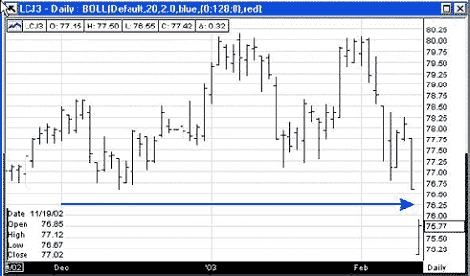
But, what about a spread between Live Cattle and Feeder Cattle?
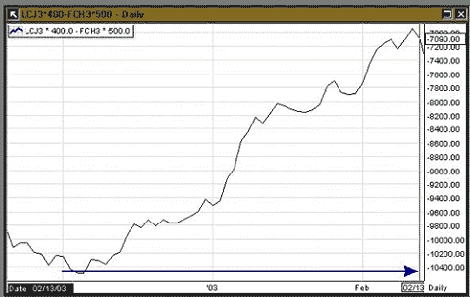
The spread moved from -10,200 to -7,200 = $3,000 per contract. The margin required to put on this spread was only $540. The return on margin is more than 550%.
Lastly, we show you another intermarket spread. This one was made between Euro and British Pound. Although you might have made money on a Euro trade, you would have suffered from serious whipsaw during the entire length of the trade.
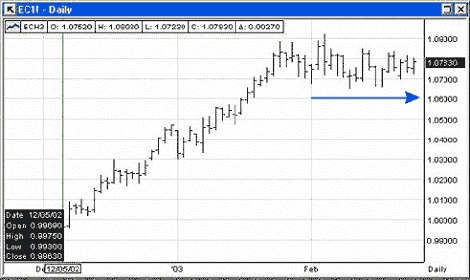
What about a spread between the Euro and the British Pound?
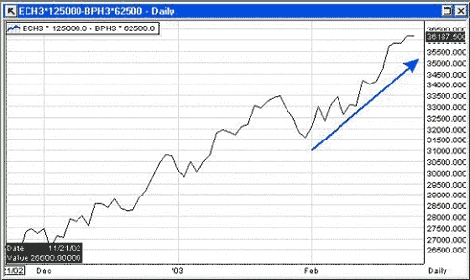
You didn't have to be in this spread for very long in order to take some fat profits: During February the spread moved from $32,500 to $36,187.50 = $3,687.50 per contract.
How do I start trading spreads?
We can barely scratch the surface of what is available in the almost lost art of spread trading. There are times when seasonal spreads, coupled with chart formations, make a lot of sense. Backwardation in any market often provides an excellent signal for entry into a spread.
How professional traders optimize profits
Futures spread trading is probably the most profitable, yet safest way to trade futures. Almost every professional trader uses spreads to optimize his profits. Trading spreads offers many advantages which make it the perfect trading instrument, especially for beginners and traders with small accounts (less than $10,000).
The following example of a Soybean-Spread shows the advantages of futures spread trading:

Example: Long May Soybeans (SK3) and Short November Soybeans (SX3)
Four Advantages of Futures Spread Trading
Advantage 1: Easy to trade
Do you see how nicely this spread starts trending in mid February? Whether you are a beginner or an experienced trader, whether you use chart formations or indicators, the existence of a trend is obvious. Spreads tend to trend much more dramatically than outright futures contracts. They trend without the interference and noise caused by computerized trading, scalpers, and market movers.
Advantage 2: Low Margin requirements
Many spreads have reduced margin requirements, which means that you can afford to put on more positions. While the margin on an outright futures position in corn is $540, a spread trade in corn requires only $135 -- 25% as much. That's a great advantage for traders with a small account. With a $10,000 trading account risking 8% of your account, you can enter 6 corn spreads, instead of only 1-2 outright corn futures trade. How's that for leverage?
Advantage 3: Higher return on margin
Each point in the spread carries the same value ($50) as each point in the outright futures ($50). That means that on a 3 point favorable move in corn futures or a 3 point favorable move in the spread, you would earn $150. However, the difference in return on margin is extraordinary:
Corn futures - $150/$540 = 27.8% return
Corn spread - $150/$135 = 111% return
And keep in mind that you can trade 6 times as many spread contracts as you can outright futures contracts. In our example you would achieve a 24 times higher return on you margin.
Advantage 4: Low time requirements
You don't have to watch a spread all day long. You do not need real-time data. The most effective way to trade spreads is using end-of-day data. Therefore, spread trading is the best way to trade if you do not want to watch or cannot watch your computer all day long (i.e. because you have a daytime job). And you can save all the money you would have had to spend for real-time data systems (up to $600 per month).
So where is the catch?
If futures spread trading is so fantastic, why does it seems that hardly anybody trades spreads? Well, it is not true that hardly anybody trades spreads: the professional traders do, every day. But either by accident or design, the whole truth of spread trading has been hidden from the public over the years.
The purpose of this website is to inform you about futures spread trading. In the following we will answer the four frequently asked questions:
- What is a spread?
- Why trade spreads?
- What can you expect when trading spreads?
What Is a Spread?
A spread is defined as the sale of one or more futures contracts and the purchase of one or more offsetting futures contracts. You can turn that around to state that a spread is the purchase of one or more futures contracts and the sale of one or more offsetting futures contracts. A spread is also created when a trader owns (is long) the physical vehicle and offsets by selling (going short) futures.
Furthermore, a spread is defined as the purchase and sale of one or more offsetting futures contracts normally recognized as a spread by the fact that the two sides of the spread are actually related in some way. This explicitly excludes those exotic spreads put forth by some vendors, which are nothing more than computer generated coincidences which are not in any way related. Such exotic spreads as Long Bond futures and Short Bean Oil futures may show up as reliable computer generated spreads, but bean oil and bonds are not really related. Such spreads fall into the same category as believing the annual performance of the U.S. stock market is somehow related to the outcome of the Super Bowl sporting event.
In any case, for tactical reasons in carrying out a particular strategy, you want to end up with:
- simultaneously long futures of one kind in one month, and short futures of the same kind in another month. (Intramarket Calendar Spread)
- simultaneously long futures of one kind, and short futures of another kind. (Intermarket Spread)
- long futures at one exchange, and short a related futures at another exchange. (Inter-exchange Spread)
- long an underlying physical commodity, and short a futures contract. (Hedge)
- long an underlying equity position, and short a futures contract. (Hedge)
- long financial instruments, and short financial futures. (Hedge)
- long a single stock futures and short a sector index.
The primary ways in which this can be accomplished are:
- Via an Intramarket spread.
- Via an Intermarket spread.
- Via an Inter-exchange spread.
- By ownership of the underlying and offsetting with a futures contract.
Intramarket Spreads
Officially, Intramarket spreads are created only as calendar spreads. You are long and short futures in the same market, but in different months. An example of an Intramarket spread is that you are Long July Corn and simultaneously Short December Corn.
Intermarket Spreads
An Intermarket spread can be accomplished by going long futures in one market, and short futures of the same month in another market. For example: Short May Wheat and Long May Soybeans.
Intermarket spreads can become calendar spreads by using long and short futures in different markets and in different months.
Inter-Exchange Spreads
A less commonly known method of creating spreads is via the use of contracts in similar markets, but on different exchanges. These spreads can be calendar spreads using different months, or they can be spreads in which the same month is used. Although the markets are similar, because the contracts occur on different exchanges they are able to be spread. An example of an Inter-exchange calendar spread would be simultaneously Long July Chicago Board of Trade (CBOT) Wheat, and Short an equal amount of May Kansas City Board of Trade (KCBOT) Wheat. An example of using the same month might be Long December CBOT Wheat and Short December KCBOT Wheat.
Why Spreads?
The rationale behind spread trading is one of the best-kept secrets of the insiders of the futures markets. While spreading is commonly done by the market "insiders," much effort is made to conceal this technique and all of its benefits from "outsiders," you and me. After all, why would the insiders want to give away their edge? By keeping us from knowing about spreading, they retain a distinct advantage.
Spreading is one of the most conservative forms of trading. It is much safer than the trading of outright (naked) futures contracts. Let's take a quick look at some of the benefits of using spreads:
- Intramarket, and some Intermarket, spreads require considerably less margin, typically around 25% - 75% of the margin needed for outright futures positions.
- Intramarket, and some Intermarket, spreads offer a far greater return on investment than is possible with outright futures positions. Why? Because you are posting less margin for the same amount of possible return.
- Spreads, in general, trend more often than do outright futures.
- Spreads often trend when outright futures are flat.
- Spreads can be filtered by virtue of seasonality, backwardation, and carrying charge differentials, in addition to any other filters you might be using in your trading.
- Spreads can be used to create partial futures positions. In fact, virtually anything that can be done with options on futures can be accomplished via spread trading.
- Spreads allow you to take less risk than is available with outright futures positions. The amount of risk between two Intramarket futures positions is usually less than the risk in an outright futures position. The risk between owning the underlying and holding a futures contract involves the least risk of all. Spreads make it possible to hedge any position you might have in the market. Whether you are hedging between physical ownership and futures, or between two futures positions, the risk is lower than that of outright futures. In that sense, every spread is a hedge.
- Spread order entry enables you to enter or exit a trade using an actual spread order, or by independently entering each side of the spread (legging in/out).
- Spreads are one of the few ways to obtain decent fills by legging in/out during the market Closing.
- Live data is not needed for spread trading, saving you $$ in exchange fees.
- You will not be the victim of stop running when using Intramarket spreads.
What Can You Expect?
Here is an example of what you can expect from Intramarket spread trading. We think you may be pleasantly surprised!!

This spread was entered not only on the basis of seasonality, but also by virtue of the formation known as a Ross hook (Rh). The spread moved from -69.0 to -7.5 = $3,075 per contract. The margin required to put on this spread was only $608, thus the return on margin is more than 500%.
Here is an example of an Intermarket spread. Look at the the following chart: Would you want to have been long live cattle from December until February?

But, what about a spread between Live Cattle and Feeder Cattle?

The spread moved from -10,200 to -7,200 = $3,000 per contract. The margin required to put on this spread was only $540. The return on margin is more than 550%.
Lastly, we show you another intermarket spread. This one was made between Euro and British Pound. Although you might have made money on a Euro trade, you would have suffered from serious whipsaw during the entire length of the trade.

What about a spread between the Euro and the British Pound?

You didn't have to be in this spread for very long in order to take some fat profits: During February the spread moved from $32,500 to $36,187.50 = $3,687.50 per contract.
How do I start trading spreads?
We can barely scratch the surface of what is available in the almost lost art of spread trading. There are times when seasonal spreads, coupled with chart formations, make a lot of sense. Backwardation in any market often provides an excellent signal for entry into a spread.
Last edited by a moderator:
